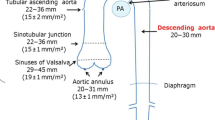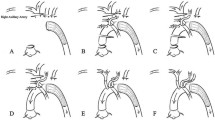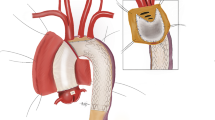Abstract
During the last decade, treatment paradigm for degenerative aortic arch aneurysms has been changed by a better understanding of the pathophysiology of brain complication and introduction of endovascular technologies. To avoid neurocognitive dysfunction, safe duration of deep hypothermic circulatory arrest is now considered <25 min, and retrograde cerebral perfusion became less frequently used. Selective cerebral perfusion (SCP) is not associated with neurocognitive decline unless profound hypothermia (<20 °C) is used, which may suggest profound hypothermic SCP is not advantageous but may be detrimental. Attempts have been made to use mild to moderate hypothermia during SCP, and safe duration of distal circulatory arrest seems <60 min at 28 °C to avoid ischemic spinal cord injury. Three-vessel perfusion seems advantageous to provide adequate brain and spinal cord protection. To avoid aortogenic brain atheroembolism in the high risk patients, we previously proposed the “isolation” technique, where SCP is established before systemic perfusion. This technique has subsequently been modified to use both axillary and left carotid arteries for systemic arterial return, so that aortogenic emboli may not enter the brain circulation. In the TEVAR (thoracic endovascular aortic repair) era, hybrid operations such as the frozen elephant trunk or TEVAR completion after the elephant trunk are increasingly performed for extensive or distal arch aneurysms. It should be noted, however, that the frozen elephant trunk operation for extensive aneurysms carries an increased risk of paraplegia, and for distal arch aneurysms its outcome is not better than that after the standard open repair in Japan.
Similar content being viewed by others
References
Kazui T, Washiyama N, Muhammad BA, Terada H, Yamashita K, Takinami M. Improved results of atherosclerotic arch aneurysm operations with a refined technique. J Thorac Cardiovasc Surg. 2001;121:491–9.
Shiiya N, Kunihara T, Imamura M, Murashita T, Matsui Y, Yasuda K. Surgical management of atherosclerotic aortic arch aneurysms using selective cerebral perfusion: 7-year experience in 52 patients. Eur J Cardiothorac Surg. 2000;17:266–71.
Ergin MA, Uysal S, Reich DL, Apaydin A, Lansman SL, McCullough JN, et al. Temporary neurological dysfunction after deep hypothermic circulatory arrest: a clinical marker of long-term functional deficit. Ann Thorac Surg. 1999;67:1887–90.
Lin R, Svensson L, Gupta R, Lytle B, Krieger D. Chronic ischemic cerebral white matter disease is a risk factor for nonfocal neurologic injury after total aortic arch replacement. J Thorac Cardiovasc Surg. 2007;133:1059–65.
Morimoto N, Okada K, Uotani K, Kanda F, Okita Y. Leukoaraiosis and hippocampal atrophy predict neurologic outcome in patients who undergo total aortic arch replacement. Ann Thorac Surg. 2009;88:476–81.
Okada T, Shimamoto M, Yamazaki F, Nakai M, Miura Y, Itonaga T, et al. Insights of stroke in aortic arch surgery: identification of significant risk factors and surgical implication. Gen Thorac Cardiovasc Surg. 2012;60:268–74.
Griepp RB. Cerebral protection during aortic arch surgery. J Thorac Cardiovasc Surg. 2001;121:425–7.
McCullough JN, Zhang N, Reich DL, Juvonen TS, Klein JJ, Spielvogel D, et al. Cerebral metabolic suppression during hypothermic circulatory arrest in humans. Ann Thorac Surg. 1999;67:1895–9.
Rokkas CK, Kouchoukos NT. Single-stage extensive replacement of the thoracic aorta: the arch-first technique. J Thorac Cardiovasc Surg. 1999;117:99–105.
Ueda Y, Miki S, Kusuhara K, Okita Y, Tahata T, Yamanaka K. Surgical treatment of aneurysm or dissection involving the ascending aorta and aortic arch, utilizing circulatory arrest and retrograde cerebral perfusion. J Cardiovasc Surg (Torino). 1990;31:553–8.
Ehrlich MP, Hagl C, McCullough JN, Zhang N, Shiang H, Bodian C, et al. Retrograde cerebral perfusion provides negligible flow through brain capillaries in the pig. J Thorac Cardiovasc Surg. 2001;122:331–8.
Okita Y, Minatoya K, Tagusari O, Ando M, Nagatsuka K, Kitamura S. Prospective comparative study of brain protection in total aortic arch replacement: deep hypothermic circulatory arrest with retrograde cerebral perfusion or selective antegrade cerebral perfusion. Ann Thorac Surg. 2001;72:72–9.
Usui A, Miyata H, Ueda Y, Motomura N, Takamoto S. Risk-adjusted and case-matched comparative study between antegrade and retrograde cerebral perfusion during aortic arch surgery: based on the Japan Adult Cardiovascular Surgery Database : the Japan Cardiovascular Surgery Database Organization. Gen Thorac Cardiovasc Surg. 2012;60:132–9.
Harrington DK, Bonser M, Moss A, Heafield MT, Riddoch MJ, Bonser RS. Neuropsychometric outcome following aortic arch surgery: a prospective randomized trial of retrograde cerebral perfusion. J Thorac Cardiovasc Surg. 2003;126:638–44.
Di Eusanio M, Schepens MA, Morshuis WJ, Di Bartolomeo R, Pierangeli A, Dossche KM. Antegrade selective cerebral perfusion during operations on the thoracic aorta: factors influencing survival and neurologic outcome in 413 patients. J Thorac Cardiovasc Surg. 2002;124:1080–6.
Spielvogel D, Etz CD, Silovitz D, Lansman SL, Griepp RB. Aortic arch replacement with a trifurcated graft. Ann Thorac Surg. 2007;83:S791–5.
Ozatik MA, Kucuker SA, Tuluce H, Sartias A, Sener E, Karakas S, et al. Neurocognitive functions after aortic arch repair with right brachial artery perfusion. Ann Thorac Surg. 2004;78:591–5.
Pacini D, Di Marco L, Leone A, Tonon C, Pettinato C, Fonti C, et al. Cerebral functions and metabolism after antegrade selective cerebral perfusion in aortic arch surgery. Eur J Cardiothorac Surg. 2010;37:1322–31.
Hiraoka K, Kawatsu S, Mori E, Saiki Y. Total aortic arch replacement using hypothermic circulatory arrest with antegrade selective cerebral perfusion: are there cerebral deficits other than frank stroke? Gen Thorac Cardiovasc Surg. 2012;60:345–9.
Svensson LG, Nadolny EM, Penney DL, Jacobson J, Kimmel WA, Entrup MH, et al. Prospective randomized neurocognitive and S-100 study of hypothermic circulatory arrest, retrograde brain perfusion, and antegrade brain perfusion for aortic arch operations. Ann Thorac Surg. 2001;71:1905–12.
Uysal S, Lin HM, Fischer GW, Di Luozzo G, Reich DL. Selective cerebral perfusion for thoracic aortic surgery: association with neurocognitive outcome. J Thorac Cardiovasc Surg. 2012;143:1205–12.
Bachet J, Guilmet D, Goudot B, Termignon JL, Teodori G, Dreyfus G, et al. Cold cerebroplegia. A new technique of cerebral protection during operations on the transverse aortic arch. J Thorac Cardiovasc Surg. 1991;102:85–93.
Shiiya N, Asada M, Matsui Y, Sakuma M, Oba J, Gohda T, et al. Clinical results of selective cerebral perfusion during reconstruction of the transverse aortic arch. Nippon Kyobu Geka Gakkai Zasshi. 1994;42:1858–64.
Tanaka J, Shiki K, Asou T, Yasui H, Tokunaga K. Cerebral autoregulation during deep hypothermic nonpulsatile cardiopulmonary bypass with selective cerebral perfusion in dogs. J Thorac Cardiovasc Surg. 1988;95:124–32.
Halstead JC, Spielvogel D, Meier DM, Weisz D, Bodian C, Zhang N, et al. Optimal pH strategy for selective cerebral perfusion. Eur J Cardiothorac Surg. 2005;28:266–73.
Dahlbacka S, Alaoja H, Makela J, Niemela E, Laurila P, Kiviluoma K, et al. Effects of pH management during selective antegrade cerebral perfusion on cerebral microcirculation and metabolism: alpha-stat versus pH-stat. Ann Thorac Surg. 2007;84:847–55.
Ohkura K, Kazui T, Yamamoto S, Yamashita K, Terada H, Washiyama N, et al. Comparison of pH management during antegrade selective cerebral perfusion in canine models with old cerebral infarction. J Thorac Cardiovasc Surg. 2004;128:378–85.
Shann KG, Likosky DS, Murkin JM, Baker RA, Baribeau YR, DeFoe GR, et al. An evidence-based review of the practice of cardiopulmonary bypass in adults: a focus on neurologic injury, glycemic control, hemodilution, and the inflammatory response. J Thorac Cardiovasc Surg. 2006;132:283–90.
Usui A, Fujimoto K, Ishiguchi T, Yoshikawa M, Akita T, Ueda Y. Cerebrospinal dysfunction after endovascular stent-grafting via a median sternotomy: the frozen elephant trunk procedure. Ann Thorac Surg. 2002;74:S1821–4.
Miyamoto Y, Fukui S, Kajiyama T, Mitsuno M, Yamamura M, Tanaka H, et al. Analysis of collateral blood flow to the lower body during selective cerebral perfusion: is three-vessel perfusion better than two-vessel perfusion? Eur J Cardiothorac Surg. 2009;35:684–7.
Kunihara T, Shiiya N, Matsuzaki K, Matsui Y. Metabolic relevance during isolation technique in total arch repair for patients at high risk with embolic stroke. Interact Cardiovasc Thorac Surg. 2008;7:58–62.
Pacini D, Leone A, Di Marco L, Marsilli D, Sobaih F, Turci S, et al. Antegrade selective cerebral perfusion in thoracic aorta surgery: safety of moderate hypothermia. Eur J Cardiothorac Surg. 2007;31:618–22.
Minatoya K, Ogino H, Matsuda H, Sasaki H, Tanaka H, Kobayashi J, et al. Evolving selective cerebral perfusion for aortic arch replacement: high flow rate with moderate hypothermic circulatory arrest. Ann Thorac Surg. 2008;86:1827–31.
Zierer A, Detho F, Dzemali O, Aybek T, Moritz A, Bakhtiary F. Antegrade cerebral perfusion with mild hypothermia for aortic arch replacement: single-center experience in 245 consecutive patients. Ann Thorac Surg. 2011;91:1868–73.
Kamiya H, Hagl C, Kropivnitskaya I, Bothig D, Kallenbach K, Khaladj N, et al. The safety of moderate hypothermic lower body circulatory arrest with selective cerebral perfusion: a propensity score analysis. J Thorac Cardiovasc Surg. 2007;133:501–9.
Etz CD, Luehr M, Kari FA, Lin HM, Kleinman G, Zoli S, et al. Selective cerebral perfusion at 28 degrees C—is the spinal cord safe? Eur J Cardiothorac Surg. 2009;36:946–55.
Della Corte A, Scardone M, Romano G, Amarelli C, Biondi A, De Santo LS, et al. Aortic arch surgery: thoracoabdominal perfusion during antegrade cerebral perfusion may reduce postoperative morbidity. Ann Thorac Surg. 2006;81:1358–64.
Matsuyama S, Tabata M, Shimokawa T, Matsushita A, Fukui T, Takanashi S. Outcomes of total arch replacement with stepwise distal anastomosis technique and modified perfusion strategy. J Thorac Cardiovasc Surg. 2012;143:1377–81.
Katz ES, Tunick PA, Rusinek H, Ribakove G, Spencer FC, Kronzon I. Protruding aortic atheromas predict stroke in elderly patients undergoing cardiopulmonary bypass: experience with intraoperative transesophageal echocardiography. J Am Coll Cardiol. 1992;20:70–7.
Shiiya N, Kunihara T, Kamikubo Y, Yasuda K. Isolation technique for stroke prevention in patients with a mobile atheroma. Ann Thorac Surg. 2001;72:1401–2.
Fukuda I, Fujimori S, Daitoku K, Yanaoka H, Inamura T. Flow velocity and turbulence in the transverse aorta of a proximally directed aortic cannula: hydrodynamic study in a transparent model. Ann Thorac Surg. 2009;87:1866–71.
Minakawa M, Fukuda I, Inamura T, Yanaoka H, Fukui K, Daitoku K, et al. Hydrodynamic evaluation of axillary artery perfusion for normal and diseased aorta. Gen Thorac Cardiovasc Surg. 2008;56:215–21.
Kato M, Ohnishi K, Kaneko M, Ueda T, Kishi D, Mizushima T, et al. New graft-implanting method for thoracic aortic aneurysm or dissection with a stented graft. Circulation. 1996;94:II188–93.
Suto Y, Yasuda K, Shiiya N, Murashita T, Kawasaki M, Imamura M, et al. Stented elephant trunk procedure for an extensive aneurysm involving distal aortic arch and descending aorta. J Thorac Cardiovasc Surg. 1996;112:1389–90.
Baraki H, Hagl C, Khaladj N, Kallenbach K, Weidemann J, Haverich A, et al. The frozen elephant trunk technique for treatment of thoracic aortic aneurysms. Ann Thorac Surg. 2007;83:S819–23.
Midorikawa H, Kanno M, Ishikawa K. Fully supported open stent grafting applied with a Matsui-Kitamura (MK) stent in treatment of distal arch aneurysm. Gen Thorac Cardiovasc Surg. 2008;56:209–14.
Yamada K, Mochizuki T, Tsubota H, Funamoto M. Early and midterm outcomes of open stent-graft treatment for distal aortic arch aneurysm. Gen Thorac Cardiovasc Surg. 2008;56:490–7.
Di Bartolomeo R, Di Marco L, Armaro A, Marsilli D, Leone A, Pilato E, et al. Treatment of complex disease of the thoracic aorta: the frozen elephant trunk technique with the E-vita open prosthesis. Eur J Cardiothorac Surg. 2009;35:671–5.
Uchida N, Shibamura H, Katayama A, Sutoh M, Kuraoka M, Ishihara H. Long-term results of the frozen elephant trunk technique for the extensive arteriosclerotic aneurysm. J Thorac Cardiovasc Surg. 2010;139:913–7.
Matsuda H, Tsuji Y, Sugimoto K, Okita Y. Secondary elephant trunk fixation with endovascular stent grafting for extensive/multiple thoracic aortic aneurysm. Eur J Cardiothorac Surg. 2005;28:335–6.
Greenberg RK, Haddad F, Svensson L, O’Neill S, Walker E, Lyden SP, et al. Hybrid approaches to thoracic aortic aneurysms: the role of endovascular elephant trunk completion. Circulation. 2005;112:2619–26.
Kawaharada N, Kurimoto Y, Ito T, Koyanagi T, Yamauchi A, Nakamura M, et al. Hybrid treatment for aortic arch and proximal descending thoracic aneurysm: experience with stent grafting for second-stage elephant trunk repair. Eur J Cardiothorac Surg. 2009;36:956–61.
Obitsu Y, Koizumi N, Iida Y, Iwahashi T, Saiki N, Watanabe Y, et al. Long-term results of second-stage thoracic endovascular aortic repair following total aortic arch replacement. Gen Thorac Cardiovasc Surg. 2010;58:501–5.
Milewski RK, Szeto WY, Pochettino A, Moser GW, Moeller P, Bavaria JE. Have hybrid procedures replaced open aortic arch reconstruction in high-risk patients? A comparative study of elective open arch debranching with endovascular stent graft placement and conventional elective open total and distal aortic arch reconstruction. J Thorac Cardiovasc Surg. 2010;140:590–7.
Sakata R, Fujii Y, Kuwano H. Thoracic and cardiovascular surgery in Japan during 2009: annual report by the Japanese Association for Thoracic Surgery. Gen Thorac Cardiovasc Surg. 2011;59:636–67.
Ogino H, Ando M, Sasaki H, Minatoya K. Total arch replacement using a stepwise distal anastomosis for arch aneurysms with distal extension. Eur J Cardiothorac Surg. 2006;29:255–7.
Yoshitatsu M, Nomura F, Toda K, Katayama A, Tamura K, Katayama K, et al. The “eaves” technique for distal anastomosis in aortic arch replacement. Ann Thorac Surg. 2005;79:1422–4.
Di Eusanio M, Schepens MA, Morshuis WJ, Dossche KM, Kazui T, Ohkura K, et al. Separate grafts or en bloc anastomosis for arch vessels reimplantation to the aortic arch. Ann Thorac Surg. 2004;77:2021–8.
Flores J, Kunihara T, Shiiya N, Yoshimoto K, Matsuzaki K, Yasuda K. Extensive deployment of the stented elephant trunk is associated with an increased risk of spinal cord injury. J Thorac Cardiovasc Surg. 2006;131:336–42.
Author information
Authors and Affiliations
Corresponding author
Additional information
The review was submitted at the invitation of the editorial committee.
Rights and permissions
About this article
Cite this article
Shiiya, N. Aortic arch replacement for degenerative aneurysms: advances during the last decade. Gen Thorac Cardiovasc Surg 61, 191–196 (2013). https://doi.org/10.1007/s11748-012-0166-4
Received:
Published:
Issue Date:
DOI: https://doi.org/10.1007/s11748-012-0166-4




